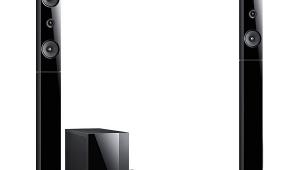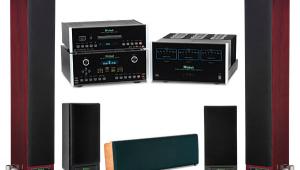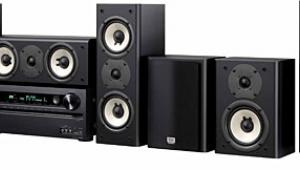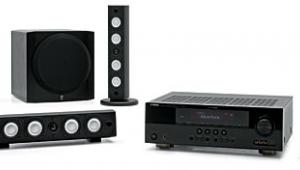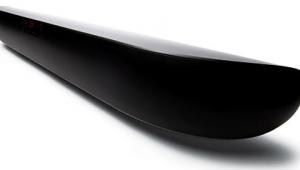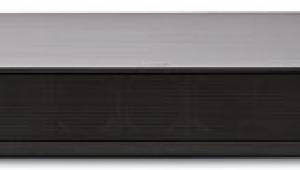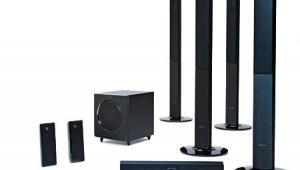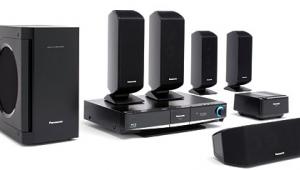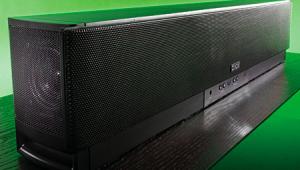Polk SurroundBar 360˚ DVD Theater
 Price: $1,200 At A Glance: DVD-processor console contains all amplification • Single cable connection • Doesn’t accept HD video or lossless audio from Blu-ray
Price: $1,200 At A Glance: DVD-processor console contains all amplification • Single cable connection • Doesn’t accept HD video or lossless audio from Blu-ray
Do You Believe in Magic?
Bar-type speaker systems like the Polk SurroundBar 360˚ are a logical response to the flat-paneling of modern homes. The form factor of a single horizontal speaker makes sense to use below the bottom edge of a flat screen (or perched atop a rear projector). But surround, by its nature, likes to spread itself around the room. And it does so for the same reason that pictures like to be big—to engulf the senses and take the viewer/listener to another place. But how can a single bar speaker spread itself around when it’s confined to a single enclosure? That’s the question Matthew Polk set out to answer with this product.
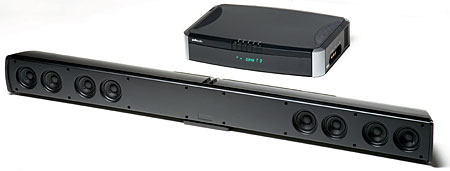
The SurroundBar 360˚—let’s make it easy on ourselves and call it the 360—answers that question in a fascinating way. Offering even the most basic details about it challenges my powers of description. For example, how do you describe a system that takes a 5.1-channel input, processes it, outputs it through four amplifier channels and eight drivers, and produces something that resembles 5.1-channel surround?
Part of the answer is that the question is incomplete. It omits the final stage of the process—the psychoacoustic reaction that occurs when the system’s output strikes the ears, infiltrates the brain, and stirs our primordial perceptions and emotions.
Piano Bar
Polk offers three speaker bars. The 42-inch SurroundBar and 51-inch SurroundBar 50 require outboard amps and signal sources of your choosing. At 44.5 inches in width, the 360 actually falls between the sizes of the other two. But the most significant difference is that it’s a complete system with a DVD drive, surround processing, and amplification. Those features are built into what Polk describes as a DVD-processor console. (The company doesn’t use the term DVD-receiver because focus groups incorrectly assumed the bar speaker could be used with any surround receiver.)
The 360 is limited in that it does not accept any high-def video sources or lossless multichannel audio. The built-in disc drive is DVD, not Blu-ray, and the back panel lacks HD-capable video inputs. The highest quality digital audio connections are TosLink and coaxial S/PDIF. That means you’ll have to connect HD source components directly to the HDTV. However, there are S-video and composite video inputs, as well as a full complement of video outputs, including HDMI and component video. To get the best out of the DVD drive, the system includes Faroudja DCDi video processing.

The piano-key controls atop the console are one of the 360’s most endearing traits. Power, volume, source select, and eject get fat buttons like the white keys on a piano. Skinnier transport controls fit between the fat buttons like the black keys on a piano. The curved front panel includes a readable blue fluorescent display. The remote is adequate, but it could have done a better job with the transport buttons, which are tiny and not well distinguished by shape or layout.
Setup is easy. For speaker placement, all I had to do was place the bar in front of my 32-inch Sharp LCD HDTV. I feared the TV and its small pedestal would need elevation, but the 360 was low enough that it didn’t block the screen. Then I placed the console in my rack, connected the console and bar with the included heavy-duty cable terminated with proprietary six-pin plugs, connected the console and HDTV via HDMI, and installed the console’s power cable. When it powered up, the system emitted a small pop.

When I stepped through the menus, I found nothing that needed changing. The 360 was already factory set for a 16:9 TV. No channel-level adjustments were available or needed. The only adjustment I made on the fly was to knock the bass down a couple of notches with the rocker switch on the remote. My room has a standing wave, but that’s no fault of the 360.
Eight Drivers, Four Pairs
The speaker itself has a gloss-black plastic enclosure that contains eight 2.5-inch drivers. They are arranged in four pairs, including two pairs at left, an 18-inch gap in the middle, and two pairs at right. The two inside pairs deliver ordinary left and right channels. The two outside pairs deliver, uh, well, let’s call it magic. To visualize, from left to right, the four pairs are: magic left, left, 18-inch gap, right, magic right.
Surround signals enter the system through the DVD-processor console. It has onboard decoding for both Dolby Digital 5.1 and DTS 5.1. For CDs and other stereo sources, it uses Dolby Pro Logic II. Once the signal is decoded, it receives further magic processing en route to the 360’s four pairs of drivers. Your ears perceive the end result as something akin to 5.1-channel surround.
The 360’s magic has roots in binaural recording, which uses two microphones placed on a dummy head in the same position as human ears. Binaural recording can produce a 180-degree soundstage with a more immersive feeling than conventional stereo.
Binaural’s weakness is interaural crosstalk on playback. Each ear hears both the left and right speakers, separated by a slight delay, which collapses the 180-degree soundstage. To defeat interaural crosstalk, binaural reproduction requires either headphones (which physically seal each channel’s sound into only the appropriate ear) or some kind of cancellation processing.

Polk’s former line of SDA (Stereo Dimensional Array) speakers used cancellation processing, which was limited to certain frequencies. It’s roughly similar to the technology that noise-cancelling headphones use. That technology reappears with new variations in the 360. This time, the goal is not just to reproduce a 180-degree stereo soundstage but a full 360-degree (hence the name) surround soundfield. That sets two tasks for our busy magic-left and magic-right channels. They must cancel interaural crosstalk for the front left and right channels and simultaneously do the same for the surround-left and surround-right channels.
In the 360, Polk positioned the magic pairs of drivers at a binaurally correct distance of 6.75 inches from the main pairs to mimic the positioning of ears on a human head. To achieve surround effects, the 360 goes beyond basic binaural theory. The goal is to make the brain distinguish between front and rear just as it does in real life.
How do your ears tell the difference between a sound you hear from the front versus an identical sound you hear behind you?
The answer has to do with your pinnae—you know, your outer ears, those meat flaps on the sides of your head. They change the reflection patterns of sounds, depending on their position. They also change the frequency response of sounds as perceived by the inner ear. The nonproprietary name for this is head-related transfer function. Polk’s magic processing mimics this natural phenomenon and fools the brain into perceiving surround effects. In practice, this effect isn’t a perfect substitute for dedicated surround speakers, but it can sneak up on you and take you by surprise.
Nerds with Tones
How exactly does the 360 assign 5.1-channel source signals to the four pairs of speakers and propagate them to the listener? To get a rough idea, I ran the channel-identification chapter of the AVIA test disc, which includes both pink noise and a male vocal identifier for each of the channels in a Dolby Digital 5.1 signal. This is what I heard:
- Log in or register to post comments
